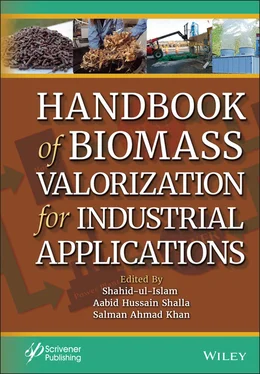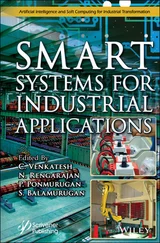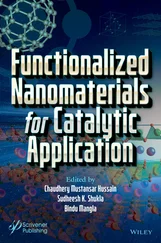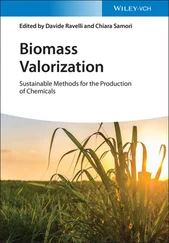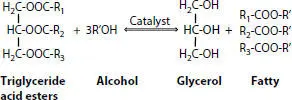
Figure 4.1 Transesterification reaction for biodiesel production.

Figure 4.2 Steps involved in the transesterification process.
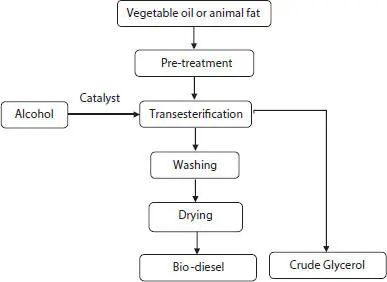
Figure 4.3 Transesterification reaction for biodiesel production.
Table 4.1 Properties of pure glycerol.
| Molecular formula |
C 3H 8O 3 |
| Molar mass |
92.09 g/mol |
| Melting point |
18 °C |
| Boiling point |
290 °C |
| Relative density |
1,260 kg/m 3 |
| Viscosity |
1.41 Pa s |
| Flash point |
160 °C |
| Specific heat |
2.43 kJ/kg K |
| Heat of vaporization |
82.12 kJ/kmol |
| Heat of formation |
667.8 kJ/mol |
| Surface tension |
63.4 mN/m |
| Self-ignition |
393 °C |

Figure 4.4 Chemical structure of pure glycerol.
4.3 Refining Process for Crude Glycerol
As discussed earlier, the crude glycerol from bio-diesel industries contains a large number of impurities and cannot be used in this form. Glycerol purification is important for removing unwanted impurities and enhancing its usability for various applications. There are several steps for the purification of crude glycerol that gives an 80–95% purity level. The commonly used steps for removing major impurities are neutralization, vacuum distillation, centrifugation, adsorption, etc. [14].
4.3.1 Neutralization/Acidification
The initial step for the refining of crude glycerol is pre-treatment using strong acid which removes the catalyst and soaps. The acids commonly used for the acidification process include phosphoric acid, sulfuric acid, and hydrochloric acid. The reaction of base catalyst and acid will generate salt and water, and its reaction with soap gives free fatty acids. The pre-treatment of crude glycerol will form three separate layers. The bottom layer is made up of inorganic salts. The glycerol is present in the middle layer with free-floating fatty acids at the top. The glycerol with 93.3% purity was obtained on chemical and physical treatment at pH 1 which is followed by neutralization using 12.5 M NaOH [15].
The acidification of crude glycerol is followed by the removal of methanol which was used in excess for high biodiesel yield. The surplus methanol is dispersed between crude glycerol and methyl ester which is having serious health and environmental hazards. This surplus methanol and water are removed by vacuum evaporation at 50–90 °C for 2 h.
4.3.3 Vacuum Distillation
Vacuum distillation is a well-established process of separating the compounds based on their boiling points using thermal energy under reduced pressure. This technique is used for the purification of a broad variety of chemicals. The distillation of glycerol should be carried out in a vacuum to prevent dehydration, polymerization of glycerol into polyglycerol, and glycerol oxidation into glyceraldehydes, glycerose, and di-hydroxylacetone. The temperature, pressure, and pH can be controlled under a vacuum [16]. However, vacuum distillation is energy demanding technique that requires high energy input and may lead to the thermal decomposition of glycerol.
Ion exchange is mainly used for the separation of impurities such as fatty acids, free ions, and salt from the glycerol. Isahak et al . [17] have used a vertical column filled with ion exchange resins for the purification of glycerol. It was found by high-performance liquid chromatography (HPLC) that a single peak of glycerol with a smooth baseline was obtained after the ion exchange process.
Adsorption is a process of deposition of ions, atoms, or molecules from solid, gas, or molecule on the surface. The activated carbon is used as an adsorbent for the final step in the purification process which removes the fatty acids, color, and additional components. Manosak et al . [18] have studied a color removal of up to 97.7% by using commercial activated carbon. In addition to color removal, few fatty acids such as myristic acid and lauric acid have been removed.
4.4 Technologies for Glycerol Valorization
After purification, the low-cost glycerol can be used for the preparation of valuable products that are important for the industries. The multifunctional structure of glycerol can be modified with several reaction pathways. Various technologies for glycerol valorization have been categorized into biological conversion and thermochemical conversion (with or without catalyst) [12]. In this respect, catalysis represents an efficient approach for the activation and valorization of glycerol.
4.4.1 Biological Conversion
A wide variety of microorganisms such as microalgae, fungi, and bacteria have been used for glycerol transformation by aerobic and anaerobic metabolism. The biological conversion was carried out in large bio-reactors according to the demand of microorganisms. The key product of anaerobic fermentation of glycerol using bacteria is 1,3-propanediol (PDO). In addition to PDO, co-products such as formate, lactic acid, succinic acid, butyric acid, acetic acid, butanol, 2,3-butanediol, acetone, ethanol, and H 2are also formed [19]. The fermentation of glycerol using microorganisms produces lactic acid, eicosapentaenoic acid (EPA), polyhydroxyalkanoates (PHA), citric acid, hydrogen, etc. The biological conversion is the efficient pathway for glycerol transformation. Though, some limitations such as low product yield, slow kinetics, low selectivity, and low reusability limit their uses.
4.4.2 Thermochemical Conversion
Glycerol can be transformed into valuable chemicals using catalytic techniques such as hydrogenolysis, etherification, steam reforming, esterification, oxidation, dehydration, and cyclization. Various catalytic methods adopted for the conversion of crude glycerol as feedstock are outlines in Figure 4.5. A large variety of valuable derivatives, such as fine chemicals, basic units for polymers, fuels, esters, synthesis gas, hydrogen, and fuel additives can be produced using these techniques.
Several solid acid catalysts such as metal oxide (A1 2O 3), zeolite H-ZSM-5, metal sulfide (CdS), immobilized liquid acid (e.g. HF/AlCl 3), heteropoly acid (e.g. H 3PW 12O 40), solid superacid (SO 4 2–/ZrO 2), natural clay, etc., have been tested for different catalytic processes [20]. None of the above catalysts have shown full potential for glycerol valorization on large scale. Carbon-based materials have a large potential to be used as supports for many active metals as well as catalysts after modification owing to their large surface area, stability in both acidic and basic solutions, functional properties, and desirable acidic or basic sites. The carbon has been used as a support for various metals such as Ru, Pt, Re, Cu, etc. for the glycerol conversion into useful products [21]. In some processes, the carbon-based catalyst with acidic sites has received tremendous interest compared to homogeneous catalysts. This is attributed to its stability, efficiency, viability, and sustainability. Furthermore, carbon catalysts can be recycled numerous times without losing their activity. In particular, carbon-based sulfonated catalysts (CBSCs) are a rapidly growing field for glycerol valorization due to their easy recovery, recyclability, long-term activity, and stability.
Читать дальше
